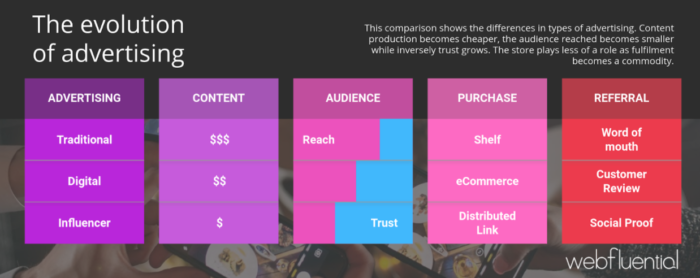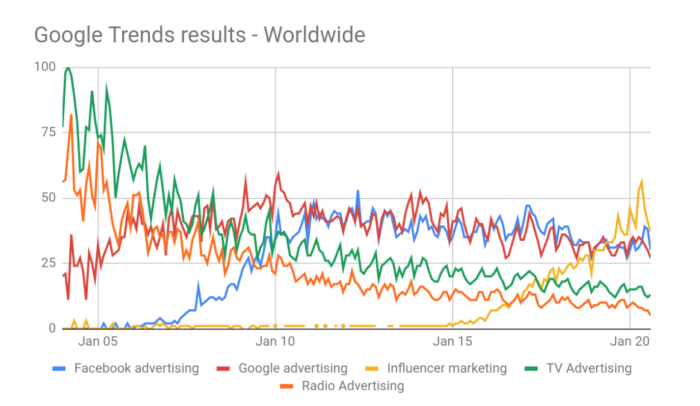Why the future of advertising is influencer?
August 18, 2020 12:26 pmWhat was one of the first lessons your parents taught you?
“Never talk to Strangers”.
Yet, what do we as brands try to do every day?
It’s not our fault though. It is behavior engrained by decades of mass production, media consumption habits, and the lag of translating real value from (digital) advertising to real results for brands.
Adtech has evolved over the last 25 years, bringing about tension between ad personalization and data privacy. The next 10 years of adtech evolution has suddenly been compressed as a result of COVID, and what this translates into, is a mass migration of ad spend from traditional mediums like outdoor, print, and even TV to new mediums like influencer.
Let’s understand what has changed, and why? And how you can navigate the noise to find real return on ad spend.

To sell a product, you need to reach a target audience with a message (content) and you need a “shelf” where your audience can purchase the product.
In the early days of mass production when mediums such as TV and Radio were used for reaching a mass audience, the objective was to produce a product and distribute it to a shelf near you for as little as possible. The “Brand” controlled the narrative and became the vehicle of trust. There were many ways to optimize the cost of reaching consumers and optimize the chances of success through shopper marketing, neuroscience, and distinctiveness on shelf, etc.
However, the problem here was that it was difficult for the brand to know who their customers actually were. In response, along came industries such as CRM, Loyalty, and post-purchase upsell and cross-sell mechanisms that add value and return by extracting more revenue from existing and incremental spend.
Over time, digital advertising and with it social media-enabled much better targeting of audiences and ad optimization. Add eCommerce, and for the first time brands actually got to meet their customers at scale, and perhaps more importantly understand which 50% of their ad budget was actually working.
But, there was still one major hurdle to overcome. The narrative that the brand once controlled had moved from a “one-to-many” model to a “many-to-many” model. The brand was no longer the host of the party, the party was now at the consumer’s house and no matter how hard the brand knocked, it was up to the consumer to unlock the door and allow the brand into the party and become part of the conversation. The power was now in the hands of the consumer.
Enter Influencer Marketing…..
The rise and rise of influencer as an advertising channel is best illustrated by the search trends in the Google trends data below:

Celebrities such as Kylie Jenner have been quick to leverage their celebrity founded on traditional channels within social media helping them to build billion-dollar brands. Others have leveraged this trend to amass huge passionate followers and launch their own businesses founded on social media alone – Chiara Ferragni – @chiaraferragni. What follows are big and small brands alike trying to unlock the consumer’s front door and join in on the conversation by leveraging consumer trust from within the party – AKA influencers.
Given the rise of the nano, and micro-influencer and that engagement is directly proportional to reach, what has evolved is:
- The cost of producing authentic content by working with influencers has come down.
- You can now reach highly engaged audiences by using more nano & micro-influencers at once through the right tech.
- Resulting in being able to leverage the trust that niche audiences have in influencers at scale.
Check Out.
Now that we understand how advertising has evolved, let’s unpack the evolution of the shelf. While COVID has added fuel to the burning of retail and migration to the online checkout, the next step in evolution moves the shelf from the brand owned eCommerce website and marketplace (read Amazon) to the point of purchase itself through a “distributed link” – meaning the checkout can now happen on any platform anywhere – on Instagram; on the influencer’s profile; on a live video or on any URL, and still, get fulfilled by “Amazon” – hence fulfillment becomes a commodity.
Lastly, you have social proof built-in, which means the content, the purchase, and the referral all happen at the same time, fuelling an increase in your Return On Ad Spend (ROAS).
What this means is that if done correctly, a big or small brand can quite literally go from zero to hero overnight.
Do you believe that the future of advertising is influencer?
Here are my top 5 tips for working with influencers to cut through the noise and improve your Return On Ad Spend.
- Work with micro & nano Influencers at scale instead of celebrities, this will be much more cost-effective.
- Allow the influencer to create the content and try not to dictate too much. Influencers know their audience needs much better than we do, if the audience smells a lack of authenticity your campaign will not work and that door will remain locked.
- Bring the Point of Purchase as close as you can to the content.
- Use Branded Content Ads to reach new audiences with the sophisticated targeting capabilities of Facebook (& Instagram).
- Ensure you are tracking your ROI and ROAS which should outperform traditional and digital ad channels.
If you have any questions or comments, feel free to reach out to [email protected]
Ryan Silberman.
Share this article






